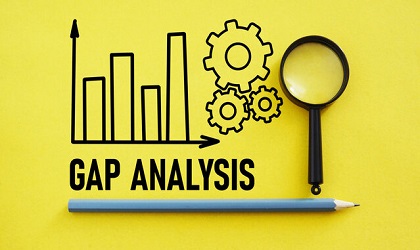Gap analysis is a powerful strategic tool that helps organizations identify the difference between their current performance and desired outcomes. By systematically evaluating the discrepancy between their present state and future goals, businesses can uncover opportunities for improvement, set clear objectives, and develop targeted strategies to achieve success.
This process can be applied across various domains, including business processes, market positioning, product development, and personal development. In this article, we will explore the key aspects of this analysis, its benefits, and how it can be effectively implemented to drive growth.

What is Gap Analysis?
The process involves comparing actual performance or outcomes with potential or desired results. It identifies shortfalls or differences between current practices and best practices or goals. These gaps can then be addressed through specific actions to improve performance, efficiency, or competitiveness.
The analysis typically involves three key components:
- Current State: The existing performance, processes, or outcomes.
- Desired State: The ideal or target performance, often based on goals, benchmarks, or best practices.
- Gap: The difference between the current and desired states, representing the areas that need improvement or change.
Understanding these discrepancies allows businesses to prioritize actions, allocate resources effectively, and develop a clear roadmap for achieving objectives.
When to Use Gap Analysis
This process is useful in various situations, including:
- Strategic Planning: Aligning current capabilities with long-term goals.
- Performance Improvement: Identifying areas where operations fall short of standards.
- Market Competitiveness: Assessing position relative to competitors.
- Product Development: Understanding unmet customer needs.
- Compliance and Risk Management: Ensuring regulatory requirements are met.
Steps in Conducting Gap Analysis
- Define the Focus Area: Clearly define the area to evaluate, such as a specific business process or product line.
- Identify the Current State: Collect data to understand current performance, analyzing key performance indicators (KPIs), financial reports, or operational metrics.
- Define the Desired State: Establish the ideal performance based on industry standards or customer expectations.
- Analyze the Gap: Compare current performance with desired outcomes to identify specific areas for improvement.
- Develop an Action Plan: Create a detailed plan to address identified gaps, including timelines and responsible parties.
- Monitor and Adjust: Regularly assess progress and make necessary adjustments to ensure continuous improvement.
Types of Gap Analysis
This analysis can be applied in various contexts, including:
- Business Gap Analysis: Identifying inefficiencies in organizational processes.
- Market Gap Analysis: Revealing unmet needs in the market for new products or services.
- Skills Gap Analysis: Assessing the gap between current employee skills and those needed for organizational goals.
- Compliance Gap Analysis: Ensuring practices meet regulatory requirements.
- IT Gap Analysis: Identifying outdated technology or insufficient cybersecurity measures.
Benefits of Gap Analysis
- Improved Decision Making: Provides clarity on performance relative to goals, enabling better resource allocation.
- Enhanced Efficiency: Identifies inefficiencies and streamlines operations, leading to cost savings.
- Strategic Alignment: Ensures all departments work towards common objectives, fostering cohesion.
- Informed Resource Allocation: Focuses resources on critical gaps rather than spreading them too thin.
- Competitive Advantage: Uncovers new growth opportunities, helping businesses stay ahead of competitors.
Challenges of Gap Analysis
While beneficial, this process can present challenges if not implemented correctly:
- Lack of Data: Insufficient data can lead to incorrect conclusions.
- Resistance to Change: Stakeholders may resist implementing necessary changes.
- Overlooking External Factors: Internal focus may overlook external influences like economic conditions.
Conclusion
Gap Analysis is vital for organizations looking to improve performance, streamline operations, and achieve strategic goals. By identifying gaps between current and desired states, businesses can develop actionable plans that lead to growth. When applied consistently, it enhances decision-making and creates a clear path for continuous improvement and long-term competitiveness.



